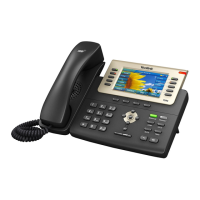Administrator’s Guide for SIP-T2_Series_T4_Series IP Phones
132
The parenthesis "( )" can be used to group together patterns, for
instance, to logically combine two or more patterns. Example:
"([1-9])([2-7])3" would match “923”, “153”, “673”, etc.
The “$” followed by the sequence number of a parenthesis means
the characters placed in the parenthesis. The sequence number
stands for the corresponding parenthesis. Example:
A replace rule configuration, Prefix: "001(xxx)45(xx)", Replace:
"9001$145$2". When you dial out "0012354599" on your phone, the IP
phone will replace the number with "90012354599". “$1” means 3
digits in the first parenthesis, that is, “235”. “$2” means 2 digits in the
second parenthesis, that is, “99”.
Replace rule is an alternative string that replaces the numbers entered by the user. IP
phones support up to 100 replace rules, which can be created either one by one or in
batch using a replace rule template. For more information on how to customize a
replace rule template, refer to Replace Rule Template on page 512.
Procedure
Replace rule can be created using the configuration files or locally.
Create the replace rule for the IP
phone.
Parameters:
dialplan.replace.prefix.X
dialplan.replace.replace.X
dialplan.replace.line_id.X
Configure the access URL of the
replace rule template.
Parameter:
dialplan_replace_rule.url
Create the replace rule for the IP
phone.
Navigate to:
http://<phoneIPAddress>/servlet
?p=settings-dialplan&q=load

